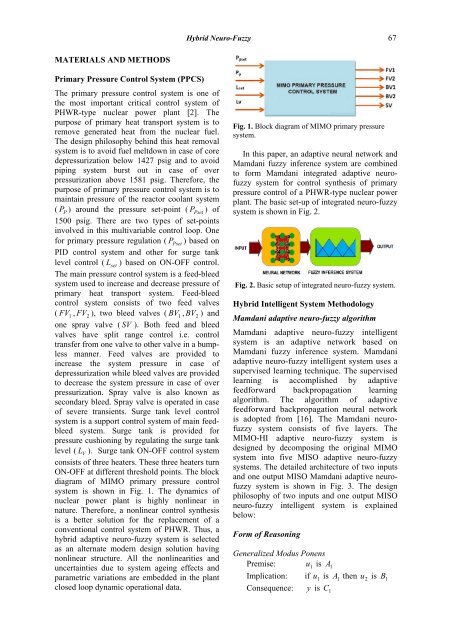Download Full Journal - Pakistan Academy of Sciences
Download Full Journal - Pakistan Academy of Sciences
Download Full Journal - Pakistan Academy of Sciences
- No tags were found...
Create successful ePaper yourself
Turn your PDF publications into a flip-book with our unique Google optimized e-Paper software.
Hybrid Neuro-Fuzzy 67MATERIALS AND METHODSPrimary Pressure Control System (PPCS)The primary pressure control system is one <strong>of</strong>the most important critical control system <strong>of</strong>PHWR-type nuclear power plant [2]. Thepurpose <strong>of</strong> primary heat transport system is toremove generated heat from the nuclear fuel.The design philosophy behind this heat removalsystem is to avoid fuel meltdown in case <strong>of</strong> coredepressurization below 1427 psig and to avoidpiping system burst out in case <strong>of</strong> overpressurization above 1581 psig. Therefore, thepurpose <strong>of</strong> primary pressure control system is tomaintain pressure <strong>of</strong> the reactor coolant system( P P ) around the pressure set-point ( P Pset ) <strong>of</strong>1500 psig. There are two types <strong>of</strong> set-pointsinvolved in this multivariable control loop. Onefor primary pressure regulation ( P Pset ) based onPID control system and other for surge tanklevel control ( L set ) based on ON-OFF control.The main pressure control system is a feed-bleedsystem used to increase and decrease pressure <strong>of</strong>primary heat transport system. Feed-bleedcontrol system consists <strong>of</strong> two feed valves( FV 1 , FV2), two bleed valves ( BV 1 , BV2) andone spray valve ( SV ). Both feed and bleedvalves have split range control i.e. controltransfer from one valve to other valve in a bumplessmanner. Feed valves are provided toincrease the system pressure in case <strong>of</strong>depressurization while bleed valves are providedto decrease the system pressure in case <strong>of</strong> overpressurization. Spray valve is also known assecondary bleed. Spray valve is operated in case<strong>of</strong> severe transients. Surge tank level controlsystem is a support control system <strong>of</strong> main feedbleedsystem. Surge tank is provided forpressure cushioning by regulating the surge tanklevel ( L V ). Surge tank ON-OFF control systemconsists <strong>of</strong> three heaters. These three heaters turnON-OFF at different threshold points. The blockdiagram <strong>of</strong> MIMO primary pressure controlsystem is shown in Fig. 1. The dynamics <strong>of</strong>nuclear power plant is highly nonlinear innature. Therefore, a nonlinear control synthesisis a better solution for the replacement <strong>of</strong> aconventional control system <strong>of</strong> PHWR. Thus, ahybrid adaptive neuro-fuzzy system is selectedas an alternate modern design solution havingnonlinear structure. All the nonlinearities anduncertainties due to system ageing effects andparametric variations are embedded in the plantclosed loop dynamic operational data.Fig. 1. Block diagram <strong>of</strong> MIMO primary pressuresystem.In this paper, an adaptive neural network andMamdani fuzzy inference system are combinedto form Mamdani integrated adaptive neur<strong>of</strong>uzzysystem for control synthesis <strong>of</strong> primarypressure control <strong>of</strong> a PHWR-type nuclear powerplant. The basic set-up <strong>of</strong> integrated neuro-fuzzysystem is shown in Fig. 2.Fig. 2. Basic setup <strong>of</strong> integrated neuro-fuzzy system.Hybrid Intelligent System MethodologyMamdani adaptive neuro-fuzzy algorithmMamdani adaptive neuro-fuzzy intelligentsystem is an adaptive network based onMamdani fuzzy inference system. Mamdaniadaptive neuro-fuzzy intelligent system uses asupervised learning technique. The supervisedlearning is accomplished by adaptivefeedforward backpropagation learningalgorithm. The algorithm <strong>of</strong> adaptivefeedforward backpropagation neural networkis adopted from [16]. The Mamdani neur<strong>of</strong>uzzysystem consists <strong>of</strong> five layers. TheMIMO-HI adaptive neuro-fuzzy system isdesigned by decomposing the original MIMOsystem into five MISO adaptive neuro-fuzzysystems. The detailed architecture <strong>of</strong> two inputsand one output MISO Mamdani adaptive neur<strong>of</strong>uzzysystem is shown in Fig. 3. The designphilosophy <strong>of</strong> two inputs and one output MISOneuro-fuzzy intelligent system is explainedbelow:Form <strong>of</strong> ReasoningGeneralized Modus PonensPremise: u 1 is A 1Implication: if u 1 is A 1 then u 2 is B 1Consequence: y is C 1
















